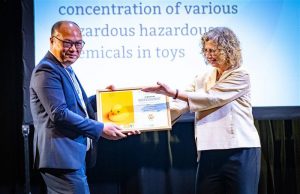Tens of thousands of tons of waste released into the environment every day is being considered as garbage, as a waste, but few know that garbage is money.
According to a report by the International Finance Corporation (IFC) and the World Bank, it is estimated that Vietnam wastes nearly 3 billion USD per year because of not recycling all plastic waste from daily life. Also, it is estimated that Organic waste worth more than $30 billion a year when nearly 70% is not recycled.
Over the past few decades, Vietnam has witnessed rapid urbanization and economic development that have contributed to changing production and consumption patterns as well as increasing emissions sources.
Total annual waste has doubled in the past 15 years and is forecasted to grow from 27 million tons in 2018 to 54 million tons in 2030. It is time to look at the garbage in the perspective of garbage economy.
Turning waste into goods
The support unit price is low, difficulty in recovering capital, which is often mentioned as the reason why businesses are not interested in investing in the field of domestic waste treatment using technology in Vietnam, but is it really due to low unit price?

About 35% into microbial fertilizer, 5% into plastic granules, the rest is burned into ash and turned into bricks. These are products that are recycled from household waste. The rate of recycling from garbage is about 95%, the remaining 5% is buried.
Instead of taking a large area to bury waste, garbage has been treated and becomes a new raw material for production in many other fields.
Garbage is something that has no value if being buried or burned, but it can be turned into money if it is treated with technology. Waste is treated effectively when the recycling rate is at its highest to promote the circular economy while minimizing the impact of environmental pollution.
An enterprise that is investing in waste treatment with technology said that with a ceiling price of 350,000 – 410,000 VND for processing 1 ton of garbage, according to current regulations, the profit brought is well worth the investment. It is a very profitable market, however it is difficult to convince investors to admit this.
According to an enterprise specialized in waste treatment “With the view and experience that we have done in many localities, the state fee paid from 18-20 USD ensures depreciation expense, construction investment cost, labor cost, cost general production materials. The benefits of enterprises depend entirely on the ability to classify, master technology and turn garbage into something useful and has economic value”.
With a treatment capacity of about 300 tons per day, each month, the waste treatment plant will collect more than 1,300 tons of microorganisms, 450 tons of plastic particles and the rest is bricks. The price of fertilizer is about 3 million VND/ton, the price of plastic resin is about 10 million VND/ton, not including bricks that are reused in other construction activities of the enterprise. It can be seen that garbage has brought a large amount of money. This is just at the factory scale. From a broad perspective on the circular economy, many argue that waste is also a sustainable basis for the development of organic agriculture in the future.
“The cultivation industry alone has reached 175 million tons of surplus, livestock is also more than 80 million tons, a few million tons of fishery, forestry… From that hundreds of millions of tons of waste that we can recycle only the by-products, not to mention the end-garbage, could bring about 30 billion USD of profit. We understand that agricultural exports in 2022 are expected to be 50 billion USD of agricultural products, recycling the by-product alone worth 30 billion USD. Garbage recycling is a the curent trend that Vietnam cannot help but follow, which will reduce costs and fight environmental pollution”, Prof. Tran Dinh Long commented.
The amount of organic matter in domestic waste currently accounts for about 70%. Solutions to deal with the amount of agricultural by-products and organic waste in urban areas will contribute to reducing environmental pollution and reducing the burden of waste treatment. At the same time, taking advantage of this resource also contributes to promoting the production of organic fertilizers at factories and households.
Waste management plays an important role in complying with the circular economy goals, which is essential for a sound circular economy to transform the needs of each country towards environmental sustainability. and zero waste.
Burying is wasting the waste
While garbage brings such economic benefits, in Vietnam about 85% of waste is being treated by landfill technology.
Particularly, Ho Chi Minh City and Hanoi spend about 1,200-1,500 billion VND per year for waste collection and treatment, accounting for 3.5% of budget expenditure. As for environmental experts, if you put garbage to landfill, it will waste 55-67% of the biomass and organic matter in solid waste.
Landfilling is a simple waste treatment method, but it is expensive and wastes land resources. Not to mention the air and groundwater are polluted during the decomposition of garbage if not handled well. At Nam Son Waste Treatment Area, Hanoi City, although there is a waste water treatment plant, which is assessed by experts as meeting the standards, the negative impacts on the environment still cannot be completely solved.
The laterite well has been unusable for 15 years because the water in the well is thick and black, Mrs. Biec’s family (Lai Son village, Bac Son commune, Soc Son district, Hanoi) had to cover it up to keep it safe.
The ponds and lakes are located between the residential area and the Nam Son landfill, the water is also black and has a bad smell for the past ten years. The people of Lai Son Village, less than 100 meters from the lake, are also used to the overflow of garbage across the street into their yard.
Looking down from above, Nam Son landfill is always overloaded with tens of meters of garbage mountains covered with tarpaulin. The waste water level in the biological lake is always rising to the edge of the embankment, at any time can overflow the bank causing pollution to residential areas and fields around the waste treatment area…
With about 10 million people, the amount of domestic waste in Hanoi every day amounts to about 7,000 tons. buried in 3 waste treatment areas, namely Nam Son, Xuan Son and Cau Dien. In which, Nam Son landfill is the largest, capable of receiving more than 4,000 tons of garbage/day and the amount of leachate is about 3,000 m3/day (excluding the amount of garbage generated by rain). The risk of environmental pollution is great.
Over 70% of garbage in Hanoi is buried, costing trillions of dong each year. Land for waste treatment yards is also up to thousands of hectares. However, the classification right from the source has not been done, making the city’s waste treatment over the years both costly, land fund, and still pollute the environment.
“One thing that is very troubling is that through the daily field visits in the area of Ba Dinh district, I personally see the waste from people’s houses and households can be recycled. Normally, people just think of garbage as a waste, but here if we actively separate garbage, then garbage is a reusable resource, which will help reduce the city’s costs to the industry. environment a lot”, said Mr. Nguyen Quang Trung, Deputy Director of Hanoi Urban Environment Company, Ba Dinh Branch.
“One day, Hanoi has about 6,500 tons of domestic waste, as well as 2,500-3,000 tons of construction waste. If construction waste sources are applied using technology for recycling, it will bring a circular economy to technical infrastructure works, limit mineral exploitation to help the Capital develop better, more efficiently and can see more economic and sustainable results. If garbage is buried, the problem of pollution control and renewable resources is not reusable, so it is very wasteful”, said Mai Trong Thai, Deputy Director of Hanoi Department of Natural Resources and Environment.
Hanoi has had investment projects in waste incineration technology to generate electricity for society, as well as policies on recycling of construction waste, building a green and circular economy… but the implementation of these projects are too slow. As for the planning of 17 waste treatment zones in Hanoi by 2030, if the burial method is maintained forever, the circular economy is not established soon and modern technology is applied, the whole capital will be surrounded by garbage and leachate.
According to the General Department of Energy, Ministry of Industry and Trade, with a population of 93 million people, each year, the amount of waste generated is nearly 35,000 tons of urban solid waste and 34,000 tons of rural domestic waste. Only in two big cities, Hanoi and Ho Chi Minh City, each city has from 7,000 to 8,000 tons of waste every day. This is a huge untapped resource.
According to the Vietnam Environment Administration, Vietnam currently has about 1,000 landfills for domestic waste, of which less than 20% are sanitary landfills. This is not only a burden on the environment, but also puts Vietnam among the 20 countries with the largest amount of waste and higher than the world average.
Inadequacy of the legal corridor to treat waste by technology
Currently, the whole country has 2 waste treatment plants with combustion technology that have been put into operation in Can Tho and Hanoi. Particularly in Can Tho, the treatment rate is about 80%, the rest still has to be buried. Hanoi has only deployed for more than 4 months, assessing how effective it is still needs time.
More broadly, for many countries in the world, waste is considered a valuable resource, while in Vietnam, the treatment of waste by technology is still very limited.
The Law on Environmental Protection stipulates that waste must be sorted at source, but after sorting, how to process, produce and recycle? How to manage and use the output of recycled products? These are the problems posed for local waste treatment. It is very necessary to implement modern waste treatment methods to gradually replace outdated landfill methods. However, choosing an effective method is also a headache for management agencies. Not to mention, from an investor’s perspective, even though they want to invest in a factory, it is not easy to get garbage to handle.
Waste can only be completely treated when it is segregated at the source. This will contribute to creating a source of raw materials for recycling activities, reducing the pressure in the stage of waste collection and treatment. According to the Law on Environmental Protection, the classification of garbage began to be implemented at the beginning of this year. Currently, some localities across the country are also implementing waste classification. However, in order to gain great economic benefits from garbage, beside classification, there is a need for the application of technology.
“I think we have to both classify and apply technology, side by side to develop together. It is impossible to classify before applying technology because people will not do the classification without processing and if we introduce technology without raw materials, without classification, we will not be able to do it so we need to find out which technology is most suitable for each type of waste”, said Mr. Ngo The Dong, Deputy General Director of Hai Phong Urban Environment One Member Co., Ltd.
Currently, there are 5 popular waste treatment models in Vietnam, including: burning waste to generate electricity; treat domestic solid waste into microbial fertilizer; bury; electrification and incineration of ordinary waste, however, there are no specific regulations on the appraisal of solid waste treatment technology, nor recommendation for domestic waste treatment technology to be applied. Therefore, localities still face many confusion when choosing technology to treat domestic waste.
“There needs to be a census, gathering forces to see how much foreign technology, how much Vietnamese technology, how businesses have done, to summarize, which is superior, which have and have not be done. For example, Japan does combustion and gasification technology, it must be classified very well, but Vietnam has not done it yet, at the beginning, the state should have a census to gather the wisdom of research institutes, of companies, enterprises will draw back, then they will offer appropriate technology for Vietnam”, GS.VS. Tran Dinh Long analyzed.
Technology will go along with many other issues such as planning. This is also one of the difficulties when implementing waste treatment technology in localities.
“Relating to the planning of locations for the construction of factories and concentrated solid waste treatment zones, there is also a difficult problem in terms of site planning, solid waste planning, as well as for incineration. power generation, there is a power generation plan for these plants. The second is the issue of investment procedures related to the cooperation between the state and enterprises in waste treatment, currently implemented under the investment mechanism in the form of public-private partnership or investor selection. According to the provisions of the Bidding Law, contractor selection is not clear,” said Le Anh Quan, Vice Chairman of Hai Phong City People’s Committee.
Mechanisms and policies are not specific, this is also a problem, causing local governments and businesses to encounter difficulties in investing in waste treatment with technology. Therefore, the treatment of garbage has no clear path, but only stops at encouraging investment and socialization.
“In many countries, the theme of garbage is public-private partnership (PPP), which is a combination of public and private. There is a private part and a public part in the garbage, so this is a story we must pay attention to, mobilizing state and private resources, but be clear about the mechanism. What does the public state do, what does the private do… For example, the government they invest in infrastructure, the private sector handle it, they both have to invest capital and then combine… Garbage has things that belong in common, for example, garbage on the street belongs to the public, but household waste is private property, so public-private cooperation is applied by many countries and brings efficiency”, Assoc.Prof.Dr. Nguyen The Chinh, Director of the Institute of Strategy, Policy on Natural Resources and Environment, Ministry of Natural Resources and Environment, said.
Currently, the collection, transportation and treatment of garbage in localities are mostly assigned to state-owned enterprises. From an investor’s perspective, garbage is money, even a lot of money, so in addition to the difficulties in the policy mechanism, it is not because of the low unit price of garbage treatment, there is no investor, but the problem is the investor. how to get garbage. According to Mr. Dang Huy Dong, former Deputy Minister of Planning and Investment, localities must organize bidding for waste treatment.
“Must bid, it’s very explicit. The beginning of the bid is very simple, who has all the documents to prove that the technology has been able to run garbage in Vietnam, meeting the criteria for emissions, wastewater and final solid waste, with cost and waste treatment costs. The cheapest one wins the bid,” said Dang Huy Dong, former Deputy Minister of Planning and Investment.
“Creating a transparent mechanism in investment and that must have an approach at one point is healthy competition in the story of waste treatment from sorting, collection, recycling, reuse, is the responsibility of the local authorities. Of course, now there are localities that do well, but there are localities that can’t do it, what is the cause, but only from that cause can we find a solution”, Assoc.Prof.Dr. Nguyen The Chinh, Director of the Institute of Strategy, Policy on Natural Resources and Environment, Ministry of Natural Resources and Environment, said.
On average, Vietnam generates about 25 million tons of domestic waste each year. Whether this enormous resource can fully take advantage of the value of waste depends on promoting policies of relevant ministries and sectors and increasing investment by localities.
The circular economy model towards recycling waste, using one industry’s waste as an input for the production of other industries will contribute to reducing pollution, towards green and sustainable growth.
The transition to a circular economy is a great opportunity for Vietnam to develop quickly and sustainably, not only achieving socio-economic and environmental goals, and responding to climate change, but also helping to achieve the goals of the 2030 Agenda for Sustainable Development.
According to VTV










